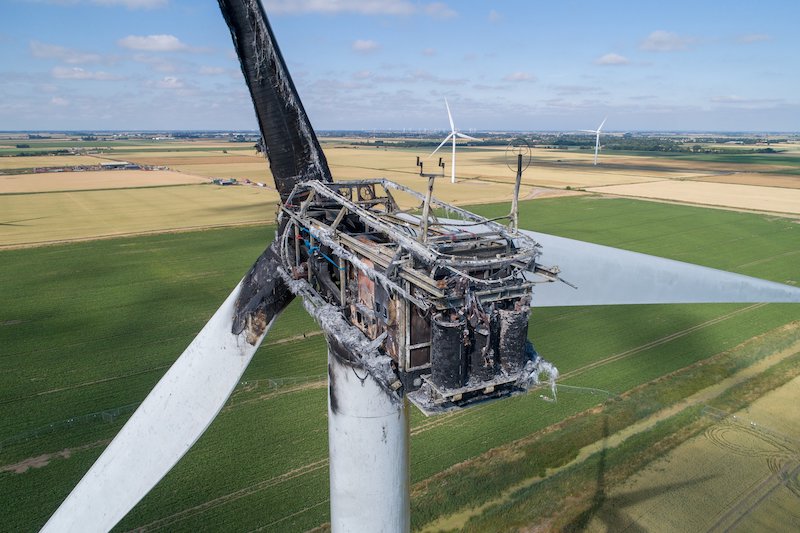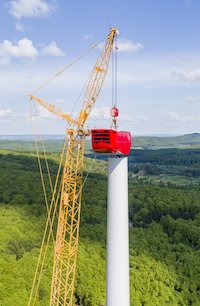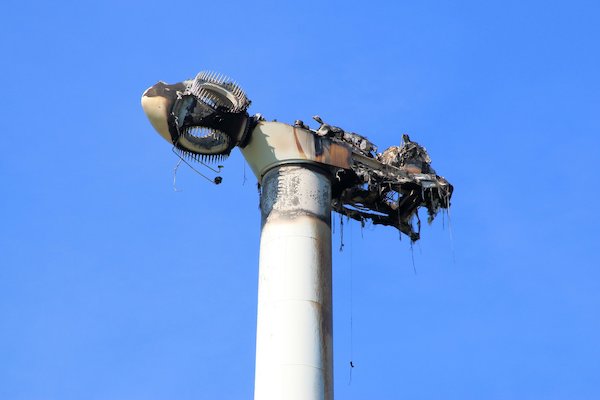Ending Turbine Fires: Collaborating controls risk to wind turbines

- Turbines continue to be lost unnecessarily to fire damage
- Wind sector must work together to control risk as we embark upon historic expansion
It is not often that wind turbines catch fire. In fact, unless they have been struck by lightning, there is no reason why they should ever experience a total loss from fire to cause the financial and reputational damage that they do. Despite this, since October 2022, at least half a dozen incidents of wind turbine fires have been reported around the world, with considerably more that go unreported.
Two turbine fires occurred within days of each other at the turn of the year: firstly, at Galgenberg wind farm in south-west Germany, then at Cullerin Range wind farm in New South Wales. As is standard procedure when the nacelle of a turbine is on fire 100m above the ground, fire crews could only watch the fire burn out and secure the surrounding area from flaming debris.
Before that, in October, Diamond Trail wind farm in Iowa County suffered more severe losses as a three-year-old turbine caught fire. Surrounding fields were caught up in the blaze, and operators were obliged to take the entire wind park offline to conduct fire risk inspections, incurring significant disruption and great expense.
Why do we continue to take our chances with fire when preventative technology is right under our noses? It is time for us all to work collaboratively in the wind sector to protect assets against controllable risks.
Truthfully, we can all do better
One of the stumbling blocks in wind turbine fire prevention is a lack of clarity over who is responsible. The simple answer is that we are all responsible.
Fire suppression technology can be installed at the manufacturing stage. Even so, the erroneous assumption that fire risk has been ‘designed out’ means that developers are not in a strong habit of asking manufacturers to install the technology.
Between owner operators and OEMs, fire risk is often not managed at all; both parties defer responsibility to one another. Consequently, the insurer is left to pick up the slack.
Owner operators will come to find that this is untenable. Despite capital flooding into the industry, we are seeing the insurance market harden in response to increased losses, and a perception that risks are being overlooked. Reliance on insurers to foot the bill ultimately leaves owner operators open to increased premiums and deductibles.
After a wind turbine fire, the average downtime is approximately 12-18 months, which could easily rack up half of million USD in lost revenue per affected turbine. If insurers no longer provide coverage for business interruption, could owner operators contend with such losses?
This unsustainable approach to fire risk is also enabled by inadequate legislation. Rather than being mandated, fire safety features are left to the owner operator’s discretion, giving the green light to save money by turning down the chance to fit the technology — even though it costs less than a rounding error in renewable project budgets.
 How we can manage fire risk together
How we can manage fire risk together
There is only one way to guard against fire, and that is by fitting wind turbines with clean agent fire suppression technology that is safe for technicians and electronics. The problem is not a lack of a solution, but helping owner operators see the value of proactively solving their fire risk issue. Presently, the industry is crippled by a “hindsight is 20/20” mentality: the value tends to be understood, and the necessary technology fitted, only after the devastating impact of a fire event.
The prevailing attitude towards turbine fires is that, because they are relatively rare, owner operators believe they won’t be one of the unlucky ones. The fact is, however, that a turbine is a high voltage machine operating in harsh weather conditions, producing plenty of heat, and will always require maintenance and testing to combat degradation.
Why gamble? We know that a claim for a burnt-out turbine comes in at 7-9 million USD, and that lost revenue from the downtime is significant. Instead, it is in the interests of insurers and owner operators — and the wind industry as a whole — to incentivize the fitting or retrofitting of proven fire suppression systems, with decreased premiums and lower deductibles for the project owner operator. This would go a long way towards reducing the volume of annual fire-related claims.
Governing bodies that are pushing for growth in the wind sector to meet net-zero targets must recognize their role in safeguarding the wind investments (both public and private) through regulation. For much of North America, there is no mandate for wind farm owner operators to conduct a fire risk assessment or install fire suppression. As the sector continues its unparalleled growth, it cannot be long before legislation in wind goes beyond the current NFPA standards that generically apply to wind farms.
The consequences of inaction
Historically, there has been a taboo around disclosing wind turbine fires. Now, however, as wind projects are set for historic deployment, this legacy must be left behind. Not only is it unsustainable, but it prevents the industry from understanding the true level of fire risk.

Failure to proactively protect against controllable risks like fire could threaten:
- The reputation of the wind sector
- Insurability of projects
- Profitability of projects
- The safety of working environments for personnel
- The safety of the surrounding environment
Controlling these risks is very easy, but it requires accountability across the board. Ultimately, owner operators should be empowered by the other key players in the wind industry to invest in appropriate fire suppression technology.
The safety, financial, environmental, and reputational risks of wind turbines fires can be quickly reduced — if not eliminated — through industry collaboration.
Ross Paznokas is the Global Business Development Manager–Clean Energy for Firetrace International, a global organization supporting renewable energy with suppression systems custom built for each client’s unique application.
Firetrace | www.firetrace.com
Author: Ross Paznokas
Volume: 2023 May/June








